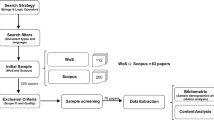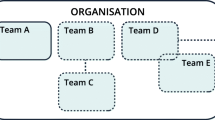Abstract
There is an increasing need to build an understanding of group facilitation in distributed requirements engineering. Group facilitation is an important element of group approaches to requirements engineering, which is being challenged by the emergence of distributed practices in software specification and development. Thus thorough empirical investigation of human facilitation in computer-mediated requirements meetings is needed. This paper presents an exploratory study of facilitation in distributed requirements teams. Three professional facilitators mediate 15 three-person groups in an experimental simulation of software requirements negotiation. Facilitation in face-to-face meetings is contrasted with four group settings in which the facilitator is physically separated from the group or co-located with key stakeholders. Rich qualitative and behavioural data enables an understanding of differences and similarities in the facilitation of face-to-face and distributed groups and of aspects that were detrimental or beneficial to their facilitation. The empirical evidence indicates that a reduced richness of social behaviours in computer-mediated group settings (1) made the group facilitation problematic but also (2) enabled certain facilitation support in the medium itself. The findings of the study are discussed in the light of existing models of the role of the facilitator. Advice from the expert facilitators is presented in the form of recommendations for the facilitation of distributed requirements teams, and worthwhile directions for further research are outlined.








Similar content being viewed by others
References
Herbsleb JD, Moitra D (2001) Global software development. IEEE Software March/June:16–20
Hiltz SR, Turrof M (1978) The network nations: human communication via computer. Addison-Wesley, Reading, MA
Kiesler S, Siegel J, McGuire TW (1984) Social psychological aspects of computer-mediated communication. Am Psychol 39(10):1123–1134
Kraemer KL, Pinsonneault A (1990) Technology and groups: assessment of the empirical research. In: Galagher J, Kraut R, Egido C (eds) Intellectual teamwork: social and technological foundations of cooperative work. Erlbaum, Mahwah, NJ, pp 373–405
McGrath JE, Hollingshead AB (1994) Groups interacting with technology: ideas, evidence, issues and an agenda. Sage, Thousand Oaks, CA
Macaulay L (1999) Seven-layer model of the role of the facilitator in requirements engineering Requirements Eng 4:38–59
Macaulay L (1996) Requirements engineering. Springer, Berlin Heidelberg New York
Tang JC, Isaacs EA (1992) Why do users like video? Studies of multimedia-supported collaboration, Technical report, SMLI TR-92–5, Sun Microsystems Lab Inc
Whittacker S, O'Conaill B (1997) The role of vision in face-to-face mediated communication. In: Finn KE, Sellen AJ, Wilbur SB (eds) Video-mediated communication. Erlbaum, Hillsdale, NJ, pp 23–35
Daly-Jones O, Monk A, Watts L (1998) Some advantages of video conferencing over high-quality audio conferencing: fluency and awareness of attentional focus. Int J Hum Comput Stud 49:21–58
Daft RL, Lengel RK (1984) Information richness: a new approach to managerial information processing and organizational design. Res Org Behav 6:191–234
Short J, Williams E, Christie B (1976) The social psychology of telecommunication. Wiley, New York
Walther JB (1996) Computer-mediated communication: impersonal, interpersonal, and hyperpersonal interaction. Commun Res 23(1):3–43
Olson JS, Olson GM, Meader D (1997) Face-to-face group work compared to remote group work with and without video. In: Finn KE, Sellen AJ, Wilbur SB (eds) Video mediated communication. Elrbaum, Hillsdale, NJ, pp 157–172
ICRE (1998) International conference on requirements engineering, Colorado Springs, CO
Westley F, Walters JA (1988) Group facilitation skills for managers. Manage Educ Dev 19(2):134–143
Wood J, Silver D (1995) Joint application development. Wiley, New York
Sullivan LP (1986) Quality function deployment. Quality Prog 19(6):39–50
Jung R, Mullert N (1987) Future workshops: how to create desirable futures. Institute for Social Inventions, London
Mumford E (1993) The participation of users in systems design: an account of the origin, evolution, and use of the ETHICS method. In: Schuler D, Namioka A (eds) Participatory design: principles and practices. Erlbaum, Hillsdale, NJ, pp 257–270
Hubbard R, Schroeder CN, Mead NR (2000) An assessment of the relative efficiency of a facilitator-driven requirements collection process with respect to the conventional interview method, ICRE'2000, Schaumburg, IL, pp 178–186
Hayne S (1999) The facilitators perspective on meetings and implications for group support systems design. Database 30(4):72–91
Viller S (1991) The group facilitator: a CSCW perspective. In: 2nd European conference on computer supported cooperative work (ECSCW), Amsterdam, 25–27 September 1991
Dubs S, Hayne SC (1992) Distributed facilitation: a concept whose time has come? Comput Support Collab Work 314–321
Wheeler B, Valacich J (1996) Facilitation, GSS, and training as sources of process restrictiveness and guidance for structure group decision making: an empirical assessment. Inform Syst Res 7(4):429–450
Damian DEH, Eberlein A, Shaw MLG, Gaines BR (2000a) The effects of communication media on group performance in requirements engineering. In: ICRE'2000, Schaumburg, IL, 19–23 June 2000
Damian, DEH, Eberlein A, Shaw MLG, Gaines BR (2000b) Using different communication media in requirements negotiations. IEEE Software May/June:28–36
Bales RF, Cohen SP (1979) SYMLOG: a systems for the multiple level observation of groups. Collier Macmillan, London
Siegel S (1956) Nonparametric statistics for the behavioural sciences. McGraw-Hill, New York
Acknowledgements
Financial assistance was made available by the Industrial Research Chair in Software Engineering and the Alberta Software Engineering Research Council. Thanks are due to the facilitators and participants in the study.
Author information
Authors and Affiliations
Corresponding author
Appendices
Appendices
1.1 Appendix 1
The role description for system users is shown in Table 4 and the requirements to be negotiated is shown in Table 5.
1.2 Appendix 2: SYMLOG analysis
SYMLOG [1] is a methodology for the observation, coding, and analysis of group dynamics. It assumes that group interaction can be measured in terms of three dimensions. Each dimension represents a continuum on which people can be positioned according to their behaviour as group members. Dominant or submissive behaviours associated with perceived influence and power constitute an upward–downward (U–D) continuum. The socio-emotional oriented behaviour is assessed along a positive–negative (P–N) continuum. It illustrates a person's concern for establishing and maintaining interpersonal bonds with others. The task-oriented behaviour is assessed on the forward–backward (F–B) continuum; it illustrates an individual's concern for performance.
These dimensions are the three orthogonal dimensions in a cube (see Fig. 9), where the one-, two-, and three-letter codes (e.g., PB, UNF) represent behavioural codes [29]. Using the standard SYMLOG coding schema, a field diagram of the interaction is generated (such as those in Figs 7 and 8). The field diagram is a visual representation of images of group members in a two-dimensional plane whose vertical axis is the F–B dimension and the horizontal axis is the P–N dimension. The image of each group member is represented in this field as a circle whose radius conveys the level of dominance. The larger the circle, the more dominant the person.
These field diagrams are obtained as follows. For each interaction act, a SYMLOG coder records the following information: (1) the time of the act, (2) who is the sender, (3) who is the receiver, (4) a specification of whether the observed behaviour was overt or non-verbal, (5) the behavioural code, and (6) a comment describing the behaviour topic. For instance, a message sent by John to Mary showing dominant and unfriendly behaviour, at minute 23 of the interaction, would be coded "23 John Mary ACT UN 'Overrides others in conversation'."
After all interaction acts have been coded, raw interaction scores are calculated for each group member (initiator of messages) with respect to U, D, P, N, F, and B directions (see Table 6). For example, if a message sent by John was rated UN then 1 U is added to u i and 1 N to n i counters respectively. These counters are defined for each group member and are used in defining plotting data for the SYMLOG field diagram. These counters are shown for the P–N dimension, but it applies to the other two dimensions as well. Once the raw interaction scores are computed for all members, they are transformed into aggregated data for plotting SYMLOG field diagrams using the formula for Location of each Participant (Table 6). The field diagram summarises the average group behaviour for each member as a circle in a two-dimensional plane and whose radius conveys the level of dominance (the value of U–D dimension).
Rights and permissions
About this article
Cite this article
Damian, D.E., Eberlein, A., Shaw, M.L.G. et al. An exploratory study of facilitation in distributed requirements engineering. Requirements Eng 8, 23–41 (2003). https://doi.org/10.1007/s00766-002-0164-7
Received:
Accepted:
Published:
Issue Date:
DOI: https://doi.org/10.1007/s00766-002-0164-7





